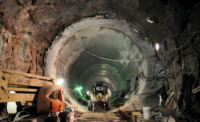Early autumn of 2010 may well have been the rock bottom point for the New York region’s design and construction market. That’s when it was clear that its few active sectors – healthcare, K-12 schools, and higher education – had backlogs drying up and new projects delayed, adding to gloom that had already enveloped private commercial and residential construction.

And then came New Jersey Gov. Chris Christie’s announcement that the state was abandoning its commitment to the $8.7 billion Trans-Hudson Express Tunnel project – which would have built a passenger rail tunnel and stations for New Jersey Transit. The news deflated prospects for infrastructure, one of the market’s few funded sectors in the market, and carved out a low point that made a rebound in 2011 seem very unlikely.
But the year’s close introduced wisps of hope that 2011 might plant seeds of recovery, such as New York City Mayor Michael Bloomberg floating the concept of extending the No. 7 subway train to New Jersey, a $5.3 billion effort that would replace the abandoned tunnel project.
That of course leaves contractors in particular with a tough bid: survive another slow year but not weaken themselves further before a possible rebound.
The consensus certainly is that no fast rebound is imminent. “We’re in it for the better part of 2011,” says Jim Scully, principal of Scully Construction of North White Plains, N.Y.
Subcontractors face an especially harsh outlook, says Ron Berger, executive director of the Subcontractors Trade Association of New York City. He says cash flow problems and late payments from contractors and owners is devastating his ranks, with a half dozen of his members filing for bankruptcy in the last two months. “And it’s getting worse,” he says.
The slim hope sits at the end of 2011, says Mike Kolakowski, CEO of KBE Building, a contractor based in Farmington, Conn. “We may see an uptick in the industry at the end of ‘11 and into 2012, but we’re not overly optimistic,” he says.
Many contractors survived on projects started before the downturn, but as those near completion, 2011 requires expert navigation, says Joe Hogan, vice president for building services at the Associated General Contractors of New York in Albany. “The strategy is to keep working those niche areas and be careful about going too far afield,” he says.
A few contractors say they already see enough work to keep steady, such as Turner Construction, which is expecting a better 2011 than 2010 for project starts, says Pat Di Filippo, executive v.p. at the firm. “We have healthcare work in the pipeline,” he says.
And a few positive signs are popping up, including architects who see clients possibly starting projects in the third quarter next year, says Diane Harp Jones, CEO and executive v.p. of the American Institute of Architects in Connecticut.
There is a glimmer, too, in activity that a dozen real estate development attorneys at Tarter Krinsky & Drogin are seeing in residential projects in New York, says David Pfeffer, a partner at the firm. “We’re all seeing things start to percolate,” he adds. “It’s not like four or five years ago, but banks are starting to loosen up their ability to loan money at all levels.”
But until the work comes, firms have to keep key staff active in a slow market. KBE’s Kolakowski says finding that “right balance” is critical to not be out of position when the market returns.
Building Blocks for 2011
To find work in 2011, construction industry firms should aim in the same direction as 2010 – at public and institutional work, both on the building and infrastructure sides. But whether that goes beyond 2011 is unclear.
“There’s no denying that public work is the key to 2011,” says Richard Anderson, president of the New York Building Congress, which covers work in New York City. He estimates that school, transportation, infrastructure, and institutional projects combined will make up to three quarters of construction spending volume in the five boroughs next year.
Indeed, already-funded work is keeping some contractors busy, such as Conti Enterprises of Edison, N.J, which has a pair of $200 million rehabilitation projects for the Whitestone and Verrazano Narrows bridges from the Metropolitan Transportation Authority.
The two remaining years of funding for the MTA’s capital plan, as well as billion-dollar capital programs at Columbia, Fordham, and New York universities, are clearly the backbone of the current market, says Louis Coletti, president and CEO of the Building Trades Employers’ Association. But public work has its limits. “While the city is continuing to fund its capital commitment on the civil side, the question becomes, when do they have to begin to scale that back?” he asks.
In Connecticut, a big chunk of the state transportation construction spending tab is on an ongoing project – the New Pearl Harbor Memorial Bridge project, a 10-lane extradosed structure that is among $2 billion in related improvements along Interstate 95 in New Haven, says John Butts, executive director of the AGC of Connecticut.
Likewise, the Dormitory Authority of the State of New York (DASNY) is spending at about the same rate this fiscal year as it did when spending nearly $1 billion last year, says Steve Curro, managing director of construction for the agency. Much of that is on big ongoing projects – such as the $700 million John Jay College of Criminal Justice and $300 million new patient pavilion at Harlem Hospital Center – but it drops off after the next fiscal year. “We don’t have a lot of large capital projects on the design boards right now,” he adds.
The drop may be less steep at institutions not reliant on public money, such as Princeton University, which shaved its planned $3.1 billion, 10-year capital plan by $1 billion but still is active with the $180 million, 248,000-sq-ft, two-building Neuroscience Institute and the Department of Psychology project that broke ground in 2010 and is set to open in 2013. Two more large projects are in design, including the 127,000-sq-ft Andlinger Center for Energy and the Environment set for 2012, says Anne St. Mauro, assistant v.p. for facilities, design, and construction.





Post a comment to this article
Report Abusive Comment